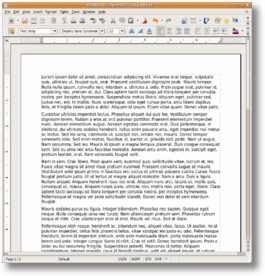OpenOffice Version 2.2 is now out. It’s official. I’m now downloading the version as we speak, thanks to Digital Nomad’s website! It fixes some vulnerabilities in the software, as well as enhancing the fonts to make for better reading.
While it doesn’t have the complete range of tools that Microsoft Office has, we’ve been running it in our business since version 1.1, with few problems. Certainly no more problems that if we’d had to update Office regularly.
InvestorBlogger’s view of OpenOffice:
1. Very useable software with a lot of power to do quite sophisticated documents. With some experience of Office, you can be up and running fairly quickly. It will take you a little while to get used to the ‘weird’ factors of Openoffice, but in truth, its weirdness isn’t so different from learning any new software.
2. If you are used to lower power word processors than this, OpenOffice offers a good, and inexpensive, way to try out more sophisticated systems, without the pain. I used to use Works 4.5 as my primary word processor, and it worked well. Subsequent versions really didn’t run well as MS decided to separate Works from Office very clearly. Works became a ‘home’ application (with *ALL* that that entailed including lots of fluff, instability in the primary apps, etc.) while Office became just that. And it’s quite clear where MS placed its long term bets.
3. It has four great applications that will really benefit you, including word processing, spreadsheets and a database. There are one or two additional programs that help out with graphics and mathematical formula, but the applications are well developed and largely stable.
4. It installs cleanly and removes just as cleanly without a reboot, without spraying files and dlls everywhere, and without a fuss.
5. When the program does crash, there is a document recovery feature that saves almost everything from loss, even newly opened files that have been saved properly yet.
6. Openoffice is available across a wide range of platforms, more than most users would ever use, but primarily of interest to us are Windows (95/98 and upwards) and Macs. This flexibility of platforms means a lot, and provides a huge competitive advantage over MS. Office is now only available on XP/Vista and an outdated version on a Mac.
Challenges:
1. Some of the normal features in Word or Office are in slightly different places, for example, if you want to change the page size, it’s now in the Format menu, NOT the File menu.
2. For Word Document users, you will need to set the file formats as a standard, which can be somewhat confusing. The ‘Options’ features are indeed extensive, but it’s not always clear what you need to change if you wish to change the behavior of the program. I had to turn off the auto-correct feature. That took nearly thirty minutes to find the option, as well as a search on the internet.
3. The standard settings are very annoying for myself, including inches not centimeters, tabs, page sizes (letter not A4), and the worst is Auto-correction, when it tries to correct tables, numbering, etc.. These features are annoying, but can be reset. MS Office does most of these to annoy users, too.
4. Openoffice offers help features but they are not as well developed as Office 97, even. More often than not, searching online provides the best help as users do post their own solutions. Finding this information isn’t always easy.
5. The conversion features from Office to Openoffice don’t always produce documents that are rendered well or accurately. Conversion has improved greatly, but users will still experience problems with spacing between lines, complex formats, and graphical differences. Tidying up these documents takes quite a bit of time.
So, we’ve already made the decision to switch over to OpenOffice in the long term. Our PCs all have OpenOffice installed, but two older systems are still running legacy copies of Office 97 and 2000. The users have already been notified that these copies cannot and will not be updated, though this has not been without some resistance.